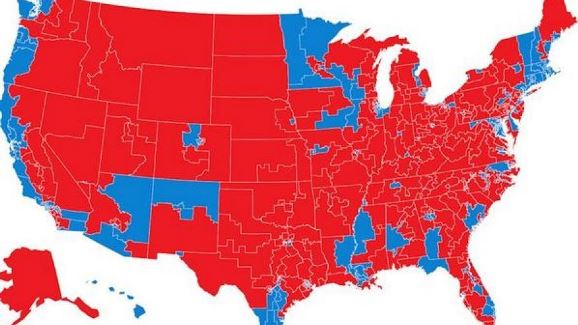Stupid Myths about Turnout, Demographics and GOP Victory
Written by Michael Medved
You’ve heard the nonsense: Republicans swept the nation because turnout in the midterm elections was shamefully low, with people of color staying home and allowing a surge of old, angry white males to dominate the contests in state after state.
This narrative may make Democrats feel better about the outcome but it bears no connection whatever to facts readily available through exit polls and Election Day tallies.
First, and most obviously, the overall voter turnout wasn’t that bad. The best available figures suggest that 36.6% of eligible voters bothered to cast their ballots, which is only very slightly less than the 37.1% that turned out in 2006, the last time the Democrats swept a midterm election, winning 23 House seats, 6 Senate seats, and 6 governorships. The difference in participation rate – half of one percent – can’t possibly explain the difference in outcome. In recent off-year elections, the stand-out race in terms of turnout occurred four years ago in 2010, with 37.8% participation – a full 1.7% better than the last Democratic sweep. The result that year featured the GOP gaining 63 (yes, 63) House seats from the Democrats.
In other words, in the last three mid-term contests the one with the highest turnout brought a Republican tidal wave, the one with the medium turnout brought a Democratic sweep, and the one with the lowest turnout (by an insignificant margin), delivered another banner year for Republicans. In other words, high turnout hardly guarantees good results for Democrats, and strong performance for Republicans in no way requires low turnout.
Meanwhile, deluded conservatives ought to stop advancing the ridiculous notion that GOP success last week derived from a massive surge of eager conservatives – the same ideologically driven voters who, according to an endlessly repeated but utterly groundless myth, stayed home in 2012 and doomed the Romney campaign to defeat. Shamefully, the leading talk radio hosts in the country have again and again cited the “three million missing conservatives” who didn’t bother to show up to block Barack Obama’s re-election.
In reality, the exit polls showed that a record 35% of all voters who cast ballots in 2012 identified themselves as “conservative” – which helped to explain why Romney drew more than a million votes more than John McCain, while Obama got nearly four million votes less than he did in 2008. For the victorious George W. Bush in 2004, conservatives amounted to only 34% of those who voted, so their percentage of the electorate actually increased for Mitt Romney. The great Ronald Reagan managed to win a landslide in 1980 with an electorate that included only 28% of self-identified conservatives.
The idea that more conservatives showed up in 2014 than in 2012 is absurd: with a much smaller electorate (which is true in every mid-term contest), the exit polls indicated at most 33 million conservatives who voted last week, compared to 46 million in the Romney-Obama race.
In both of the two most recent contests, self-described “moderates” made up the biggest portion of voters – 41% in 2012, and 40% last week. Republican candidates won among across the country because they did significantly better among this decisive voting bloc this year, scoring 45% of the moderate vote in 2014 compared to a fatal 41% two years ago, thereby cutting the Democratic advantage from an insurmountable 15% to a manageable 8%.
As to the attempt by liberal media to explain last week’s GOP wave in racial terms, it’s also a deceptive and baseless proposition. For Barack Obama’s triumphal re-election, blacks made up 13% of the electorate; for his 2014 electoral rebuke, African-Americans comprised an almost identical 12%. Whites were 72% of all voters when Obama won two years ago and they were 75% last week – yes, a notable increase but hardly enough on its own to sway the result from decisive Democratic victory to sweeping, landslide Republican success.
Republicans won in 2014 not because they faced an electorate substantially whiter or more conservative than the voters who gave Barack Obama his re-election win, or because they could work with a substantially smaller turnout than the showing that gave Democrats their last sweep in a midterm election in 2006. They succeeded this year with voting demographics that closely resembled those that prevailed in 2012, and with overall turnout nearly identical to the showing that gave Democrats their decisive victories in 2006.
The GOP succeeded not because they got a different set of voters to show up, but because they managed to persuade more of those who did. The candidates of 2014 did dramatically better with significant groups in the electorate who decisively rejected Mitt Romney and the Senatorial and Gubernatorial nominees of 2012. This year, the Republicans nationally won significantly better percentages of blacks, Latinos, Asians (actually winning the Asian vote), Jews and women. Meanwhile, they won nearly identical percentages of white voters, males, married people and those over 65—segments of the electorate that tilt reliably toward the GOP in every election.
To some extent, this success reflects the triumph of mainstream Republicanism. The successful campaign of 2014 featured no embarrassing nominees like Sharron Angle, Ken Buck, Christine O’Donnell, Todd Akin or Richard Mourdock, no strident, inflammatory talk about “legitimate rape” or Obama’s birth certificate. In more than a dozen hotly contested GOP primaries, mainstream incumbents won every one – with the single exception of Majority Leader Eric Cantor, whose conservative Virginia district still gave an easy win to David Brat, the libertarian professor who beat him in the fight for the nomination. Among the “establishment” candidates who turned back “Tea Party” challengers, each of them won big on election night – including Pat Roberts of Kansas, who prevailed with a surprisingly comfortable 11 point margin. Lindsey Graham and Lamar Alexander and Thad Cochran and Mitch McConnell all won in landslides, with 15 point margins or more. In purple state Ohio, John Kasich got a stunning 64% vote of confidence, after taking a decisively moderate and pragmatic turn in his governorship. Meanwhile, high-profile Republican candidates provided a more diverse face for the GOP, with two newly elected black members of the House (Will Hurd of Texas and Mia Love of Utah), a black Senator (Tim Scott of South Carolina), dynamic female candidates (Joni Ernst of Iowa, Nikki Haley of South Carolina) and two wildly popular Latino governors – Brian Sandovaal of Nevada and Susana Martinez of New Mexico, who racked up astonishing 71% and 58% landslides, respectively.
In short, the Republicans prevailed because they campaigned as mainstream problem-solvers, not bomb-throwing ideologues; their less polarizing rhetoric and more practical tone offered a welcome antidote to a presidency that has seemed increasingly brittle, unresponsive, inept and ideologically inflexible.
To insure future victories, Republicans should come to terms with the factors that led to their success in 2014, and set aside stupid myths about lower turnout, shifting demographics and missing or resurgent conservatives. The essential strategy for victory hasn’t changed much in 200 years. In American politics, in all major elections, you win by competing effectively for voters of every ethnicity and all ideologies, building broad coalitions, and persuading as many as possible among the persuadable.
This article was originally posted at the TruthRevolt.org blog.














